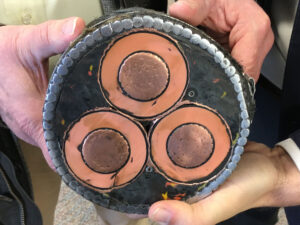
Nate Mayo of Vineyard Wind returned to the Infrastructure Committee in March to give a more robust presentation on the company’s bid for wind power.
To put the conversation in context, Nate began by giving background on the Energy Diversity Act in 2016, and the creation of the Bureau of Ocean Energy Management.
The Vineyard Wind Project overview:
Nate said the Vineyard Wind project is the most mature large scale offshore project in the US, offering 400MW & 800MW bids, including incremental scale- up for future offshore wind.
The project is 14 miles south of Martha’s Vineyard and Nantucket, and 35 miles south of Cape Cod. State and federal permits were submitted in December, 2017. Construction is scheduled to begin in 2019, operational in 2021.
One route will be chosen from the several they are exploring between Martha’s Vineyard/Nantucket and Hyannis, all done with extensive surveys with fisheries. Eelgrass is a concern as they get closer to shore. Natural resource stewardship a priority, with efforts to avoid, minimize and mitigate impact. With respect to shellfish, Nate said, there’s been a lot of success.
Power comes onshore into the Barnstable switching station. A spine in Barnstable can handle the load, but infrastructure improvements would be needed to move it into the Falmouth spur. Nate said the offshore export cables are 220 kV, solid, with no liquids (which had been a sticking point with Cape Wind).

Onshore routes are underground cable installed in concrete duct bank predominantly under existing roadways, with no mapped rare species habitat where cable goes off road. Nate said they are having good discussions with Fish and Game, with contingency plans depending on policy and buy in.
In-road construction plans are similar to previous cable installations in Massachusetts. Nate said they can work efficiently, without many of the problems faced with putting in water mains, etc. Off shore, there are existing submarine cables – two Nantucket power cables, three to Martha’s Vineyard, and one to Block Island. There is an existing cable landing in Barnstable at Kalmus Beach, installed in 2005.
There’s a proposed onshore substation in Independence Park. Vineyard Wind would put in a full containment system, which makes it safer than any other substation, Nate said. He added that while the risk of leaked fluids doing damage is very low, “it’s better to take that off the table and keep it out of the groundwater.”
Environmental review has begun. Vineyard Wind is working with the Energy Facilities Siting Board, Mass Historical Commission, Coastal Zone Consistency Certification, and MassDOT. Massachusetts Department of Environmental Protection has a major role, and Cape Cod Commission and Martha’s Vineyard Commission will do Developments of Regional Impact reviews.
Vineyard Wind also proposes building a local skilled workforce in advance of the project, which could be an incubator for the region.
The project’s financial partners are a blend of local and global expertise: AvanGrid Renewables – one of the leading providers of clean renewable wind power in the US; and Copenhagen Infrastructure Partners – a pension fund manager investing in renewable energy projects, with significant offshore wind experience in Europe. Nate said having these partners gives the project stability, and a better rate because they are familiar with offshore wind. The project is fully funded.
Vineyard Wind has asked the Technology Council for an endorsement, which does not exclude the other two companies. Bay State Wind and Deepwater Wind have also been invited to present to the Infrastructure Committee.
Bridge Closures
Members of the committee attended the meeting about upcoming lane closures at the bridge. They reported that there was a large number of people there, with good town and state representation. It was an engineering presentation, describing three phases for each bridge. Work on the Sagamore Bridge will happen in the spring, with a hard stop by Memorial Day. If they think they’re behind schedule they’ll add a third shift – currently 2 shifts of 8 hours each. Work on the Bourne bridge will start after Labor Day.
There was opposition from business owners because of the lead up to the summer. Furthermore, September is the second busiest season, so the Cape Cod Chamber of Commerce asked that they move Bourne later. It was reported that many ideas were brought forward but no changes were made to the schedule or plan.
Bridges are in general disrepair due to age, but the focus of this project is in expansion joints. The engineers said it’s a patch job, and they can’t change the structure until the bridges are replaced. They also said they had no plans to restrict traffic on the bridge – despite weight concerns
